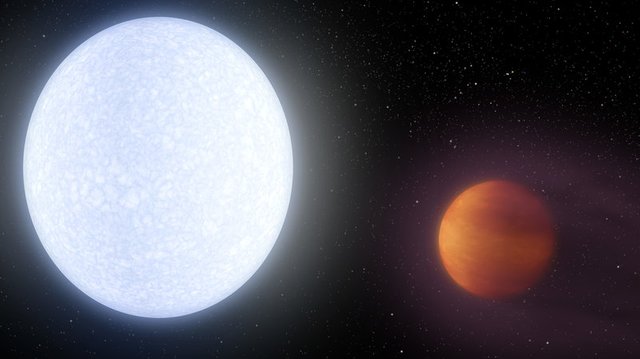Scientists Discover A Scorched Planet With A Comet-Like Tail

From NPR
Scientists have found a shockingly hot, massive, Jupiter-like planet that has a tail like a comet.Read more here: http://www.npr.org/sections/thetwo-way/2017/06/05/531561840/scientists-discover-a-scorched-planet-with-a-comet-like-tail"It is so hot that it is hotter than most stars that we know of out there," says Scott Gaudi of Ohio State University in Columbus, Ohio, whose team describes the scorching world called KELT-9b in the journal Nature.
The planet, which is around three times more massive than Jupiter, orbits a blue star about 650 light-years away from Earth. This star is nearly twice as hot as our own sun, and this planet whips around it once every one and a half Earth days.
One side of the planet is locked in perpetual night. The other side always faces the searing heat of its host star and has a surface temperature of around 7,820 degrees Fahrenheit.
"It's so hot that we think that there's no molecules that can live on the day side of this planet," Gaudi says. "Its day side would be very bright orange. Its night side would be very dark red. And it would have a cloud of evaporating hydrogen and helium, which would actually look violet."
The gas giant's atmosphere is probably evaporating at a high rate, maybe even fast enough that it would all get blasted away before the star dies. All that would remain is a rocky, barren core — if the planet has one.
"For a long time, we went back and forth about whether or not this planet could possibly be real. In fact, I had a bet with my graduate student over a very nice bottle of single malt scotch," Gaudi says. "Just for the record, I won."
In recent years, scientists have focused on finding small planets around small, cool stars, such as Proxima Centauri. That's because, with today's technology, it's much easier to study the atmospheres of planets around those stars to look for hallmarks of a potentially habitable world.
But as a result, scientists haven't spent much time looking for planets around bigger, hotter stars. What's more, these stars have certain characteristics that make finding their planets especially challenging.
So even though researchers have detected thousands of planets orbiting other stars, they know of only a half-dozen that orbit hot, A-type stars, and none has been found orbiting even hotter B-type stars. This new planet's star is just on the dividing line between those two types.
Follow @contentjunkie to stay up to date on more great posts like this one.

fake news
Exactly.
Oh those Cosmologists, always "discovering" "new" things with their telescopes. :)
#memebullshitia
Cg
This post has been ranked within the top 50 most undervalued posts in the second half of Jun 05. We estimate that this post is undervalued by $17.87 as compared to a scenario in which every voter had an equal say.
See the full rankings and details in The Daily Tribune: Jun 05 - Part II. You can also read about some of our methodology, data analysis and technical details in our initial post.
If you are the author and would prefer not to receive these comments, simply reply "Stop" to this comment.
wow. I really like this